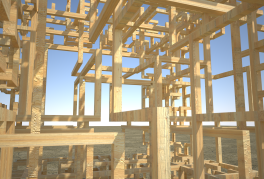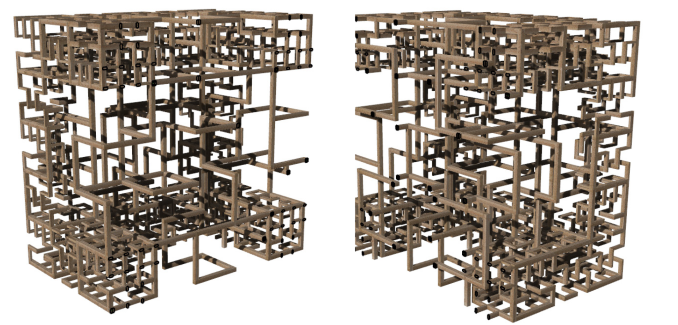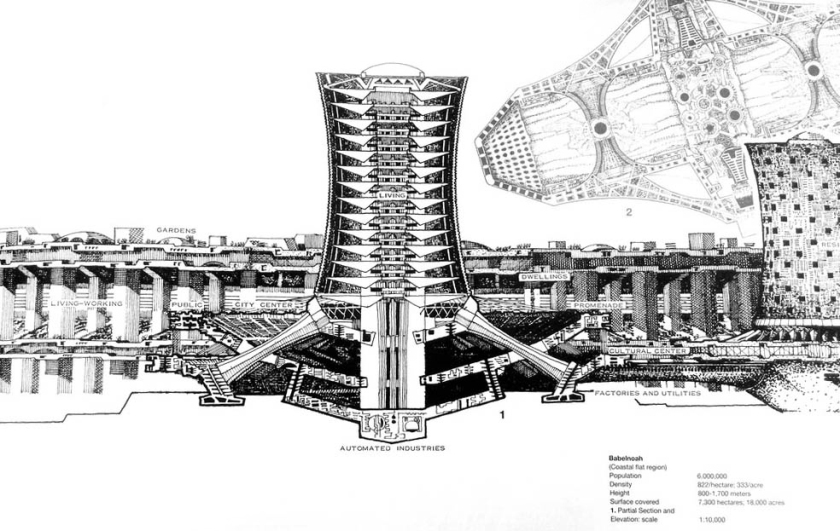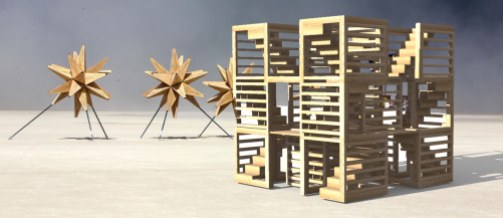Whatever has a Beginning has an End.
Inspired by a continuous fractal curve, Snakes and ‘Ladders’ takes its form from the space filling Hilbert curve; an image that grows exponentially while at the same time being bound by a square with a finite area. The curve continues to grow until all that can be seen by the eye is a solid cube. From afar, the proposal will sit on the playa as a cube made up of horizontal and vertical wooden studs fixed together. As the burner approaches the structure, it can be seen that the internal space can be explored and allows the user to interact throughout the climbable structure as they make their way to the central and upper levels. As the person makes their way inside, each layer consists of a reinforced fractal curve that can be used as a ladder progress. When the sun sets, LEDS built into the wooden studs light up the various iterations of the Hilbert Curve giving off a colourful effect to each layer inside the structure. Each layer will be programmed to allow a brighter light sequence to follow the curves creating snake-like lights that envelop the laddered structure.


Symbols to Systems
“Then it seemed like falling into a labyrinth: we thought we were at the finish, but our way bent round and we found ourselves as it were back at the beginning, and just as far from that which we were seeking at first.” Euthydemus, Plato.
My starting point began with the famous symbol from greek mythology, the labyrinth; an endlessly running meander. a structure designed and built by Daedalus for King Minos. Its function was to hold the Minotaur. It was said that Daedalus had so cunningly made the Labyrinth that he could barely escape it after he built it. However, despite this, a labyrinth will always consist of a start and an end point. The goal? Reach the centre.


Many labyrinths today are based on symmetrical patterns, first seen from the Roman Labyrinth. These represent the first real attempts to create different forms of the genre.
The term labyrinth is generally synonymous with maze. However maze refers to a complex branching of multicursal puzzle choices in path and direction, the original goal is not lost but rather relocated for creating games to challenge the user.

Looking at the work of M.C Escher I started looking at forms that could be intertwining together. As the number of staircases increase, the denser the stair maze becomes. However from this, each stair leads endlessly and no goal created.

Fractal Curve Analysis
This slideshow requires JavaScript.
Looking more into the Hilbert and Moore Fractal Curves, I constructed both out of match sticks to look at how the pathing route for each curve differed. It was noticed that the Hilbert Curve looked to be more stable when finished as it’s upper level were more supported.

Hilbert Fractal Curve Testing

Moore Fractal Curve Testing
Structural Testing
As a fractal curve will always be developed from start to end using one line, additional support will be needed.Using Karamba, I was able to generate a script that will allow me to test the strength of both fractal curves until it fails. As the structure collapses I will be able to point out the weakest areas and provide additional support to prevent the proposal from failing.


Initial Proposals & Development.
Attempting to combine the stairs with the reinforced Hilbert Curve created some uninteresting results as an initial Proposal, from this point, it was decided that to create a more complex maze would be to increase the amount of iterations and strip out the staircases.
By removing the staircase, I instead increased the size of the structure to allow additional interations to be nested externally and internally. From this a 5m x 5m Cube was to be proposed, constructed entirely out of 2in. x 4in Dried Whitewood studs. This allowed the proposal to be built cheaply and quickly using Karamba to identify weak points in the structure and reinforce them.

Proposal: Snakes & Ladders.

Snakes and Ladders originated in Ancient India, popular by the name Moksha Patam; associated with Hindu Philosophy contrasting Karma and Kama.The game has also been interpreted and used as a tool for teaching the effects of good deeds versus bad. The squares of Fulfillment, Grace and Success were accessible by the ladders, which represented virtues such as generosity, faith, and humility, while the snakes represented vices such as lust, anger, murder, and theft. The morality lesson of the game was that a person can attain salvation ‘Moksha’ through doing good and reaching the last square was attainment.
The number of ladders was less than the number of snakes as a reminder that a path of good is much more difficult to tread than a path of sins.
With Radical Ritualism being the Theme for Burning Man 2017, I believe my Proposal can itself be a cube of Fulfillment, allowing people to play the game of snakes and ladders to forget about their sins as they try to achieve ‘attainment’ by reaching the top.
The Snake.

Like the classical mobile game ‘Snake’ the lighting aims to wrap around the cube, illuminating the ‘N’ Iterations of the Hilbert Curve using LED Lighting.


The Ladder.

The structure is made up out of 2in. x 4in Dried Whitewood studs and reinforced to allow people to climb all the way to the top allowing either the external or the internal framework to be used as a ladder system to move throughout the proposal. Each iteration has start and end point which is travelled upon during the night which is reinforced by additional studs to allow no failure.



By Christopher Thornton





























